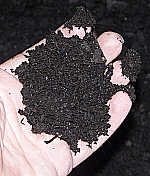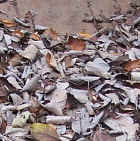|
Leaf MoldYou can make your own seed and potting compost from leaf mold - nature's very own compost.
Moreover, its low nutrient content benefits the early development of healthy seedling roots. But you can add nutrient rich comfrey leaves to the material when preparing a mix for potting on or plant containers. UsesIn addition to use for seedlings, potting on and plant containers, leaf mold is ideal for mulching around shallow rooted moisture loving plants: e.g. especially fruit (Gooseberries, Red Currants...) rhododendrons, azaleas, primulas, ferns, Cyclamen and others. Any plants that benefit from a moist environment for root development will do better when leaf mold is incorporated e.g. seedlings of French Beans and Runner Beans. Making Leaf MoldThe end product may vary depending on the type of leaves used. I use leaves from broadleaved trees. You can also use leaves from conifers such as Pine, but the product will be be more acidic. Nevertheless that is just what you need for acid loving Rhododendrons and Azaleas. I don't recommend collecting leaf mold from woodlands. This is more likely to be contaminated with weed seedlings or potentially dangerous fungi. Also, it disturbs the environment. SIMPLE METHOD After a year to 18 months the crisp yellowed leaves have turned into a black substance which has become populated by small invertebrae like Spring Tails, a few Woodlice and Worms. The finished Leaf Mold is a black fine looking material. Its granules are full of moisture. I find this leaf mold to be practically free of weeds probably because weeds seeds did not stick to the leaves. Although in the early stages it may contain potentially damaging fungi, all these have gone by the time it is properly finished. FOR POTTING COMPOST Also useful for indoor gardening and growing ferns, African Violets, Cyclamen and others. Use leaves for garden compost or for leaf mold |



